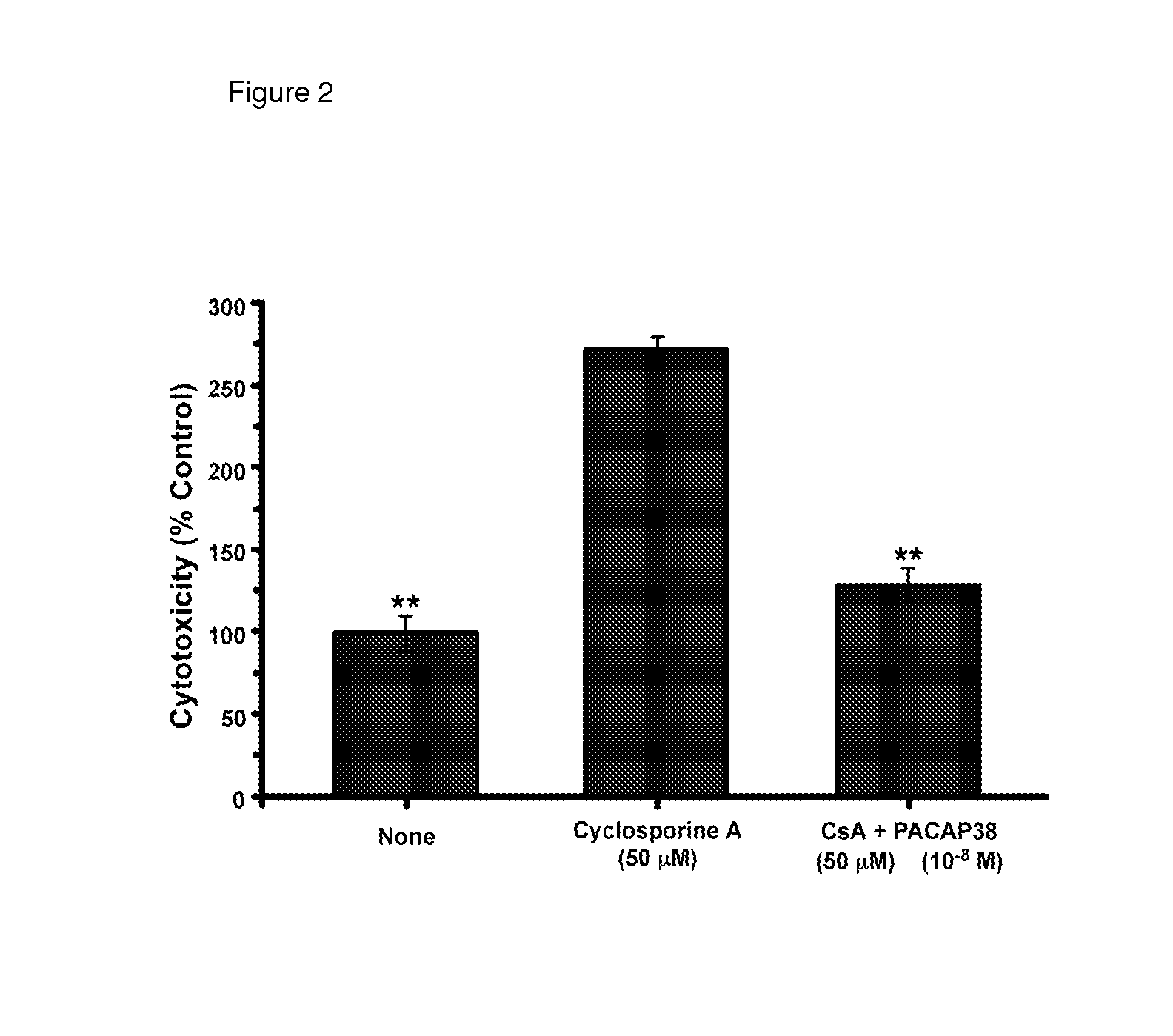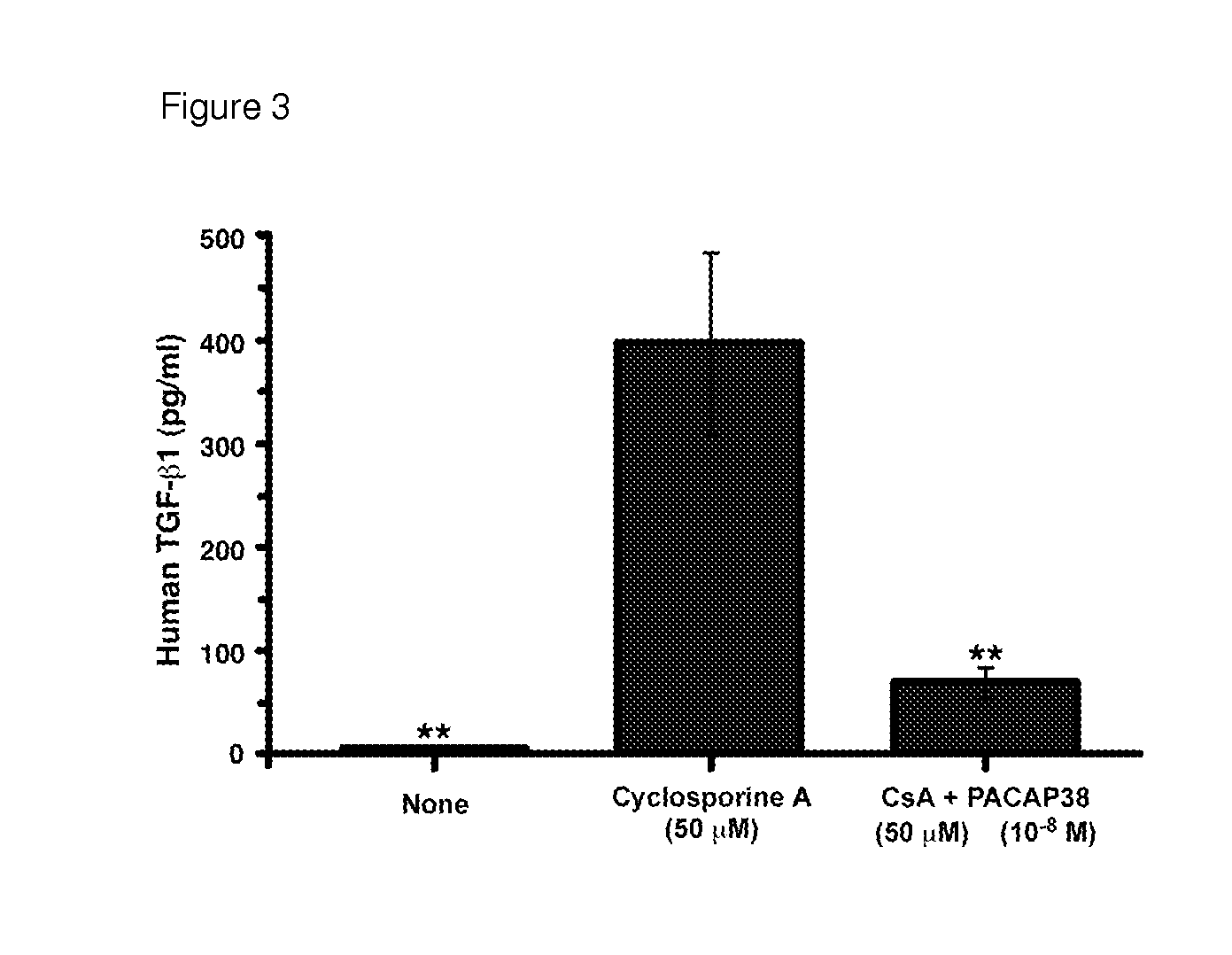USE OF PITUITARY ADENYLATE CYCLASE-ACTIVATING POLYPEPTIDE (PACAP) AND PACAP ANALOGS AS ADJUNCTIVE TREATMENTS WITH INHIBITORS OF CALCINEURIN OR INHIBITORS OF THE MAMMALIAN TARGET OF RAPAMYCIN (mTOR) COMPLEXES
a technology of adenylate cyclase and adenylate cyclase, which is applied in the field of pituitary adenylate cyclase activating polypeptide (pacap) and pacap analogs, to achieve the effect of protecting the major organs of the body
- Summary
- Abstract
- Description
- Claims
- Application Information
AI Technical Summary
Benefits of technology
Problems solved by technology
Method used
Image
Examples
example 1
Reduction of Cyclosporine A- and Tacrolimus-Induced Renal Cytotoxicity by PACAP, VIP and PACAP Analogs
[0248]Calcineurin inhibitors are the cornerstone of many multi-drug regimens for cell and organ transplantation. Calcineurin inhibitors are also frequently used in the treatment of autoimmune diseases, noninfectious uveitis, CAG codon repeat expansion diseases, and keratoconjunctivitis sicca. Nephrotoxicity is usually the “dose-limiting” toxicity for the use of either cyclosporine A or tacrolimus as a therapeutic, but injuries to the liver, pancreas, and nervous system can sometimes limit the doses that can be used to treat some patients. The toxic effects of long-term treatment with cyclosporine A or tacrolimus on the kidney are characterized histologically by glomerular sclerosis, tubular atrophy and interstitial fibrosis. The toxic effects of long-term treatment with cyclosporine A or tacrolimus on the kidney are characterized physiologically by a decrease in the glomerular filtr...
example 2
Reduction of Sirolimus-Induced Renal Toxicity by PACAP
[0253]mTOR inhibitors are frequently used in cell and organ transplantation and in autoimmune diseases, hematological cancers, tuberous sclerosis complex, and restenosis. Nephrotoxicity is usually a significant toxicity for the use of sirolimus or its newer analogs as a therapeutic, but injuries to the liver, pancreas, and nervous system can sometimes limit the doses that can be used to treat some patients.
[0254]Treatment of human renal proximal tubule epithelial cells with sirolimus resulted in a large significant increase in apoptotic cell death (FIG. 8). The addition of PACAP38 to the medium resulted in a significant dose-dependent reduction in the sirolimus-induced apoptotic cell death of the human renal proximal tubule epithelial cells. At the highest dose (10−6 M), PACAP38 almost completely prevented the apoptotic cell death caused by sirolimus.
[0255]These experiments show that PACAP38 is a potent cytoprotectant against dam...
example 3
Inhibition of Interleukin-2 Secretion and Lymphocyte Proliferation by PACAP, VIP and PACAP Analogs
[0256]An ideal cytoprotective adjunctive agent should have the same effect as the main therapeutic agent against the intended therapeutic target, but protect the patient against the deleterious “off-target” effects of the main therapeutic. Therefore, it is important to determine whether PACAP and PACAP analogs inhibit the secretion of interleukin-2 from activated lymphocytes (calcineurin inhibitors) and / or inhibit the proliferation of activated lymphocytes (mTOR inhibitors).
[0257]Jurkat cells did not secrete measurable quantities of interleukin-2 into the medium in the absence of stimulation with mitogens. However, when Jurkat cells were stimulated with PHA and PMA, large quantities of interleukin-2 could be detected in the medium (FIG. 9). The addition of PACAP38, VIP or [D-Ser2]PACAP38 to the medium resulted in a large significant inhibition of the mitogen-induced secretion of interle...
PUM
| Property | Measurement | Unit |
|---|---|---|
| molecular weight | aaaaa | aaaaa |
| pore size | aaaaa | aaaaa |
| flow rates | aaaaa | aaaaa |
Abstract
Description
Claims
Application Information
 Login to View More
Login to View More - R&D
- Intellectual Property
- Life Sciences
- Materials
- Tech Scout
- Unparalleled Data Quality
- Higher Quality Content
- 60% Fewer Hallucinations
Browse by: Latest US Patents, China's latest patents, Technical Efficacy Thesaurus, Application Domain, Technology Topic, Popular Technical Reports.
© 2025 PatSnap. All rights reserved.Legal|Privacy policy|Modern Slavery Act Transparency Statement|Sitemap|About US| Contact US: help@patsnap.com



